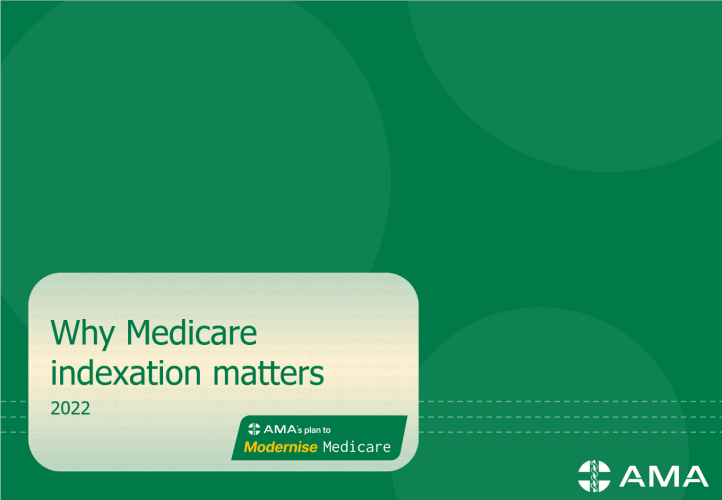Why Medicare indexation matters
AMA analysis reveals the Australian Government has saved billions because of poor Medicare indexation, with the analysis revealing a saving of $8.6 billion from just one Medicare item since 1993.

Medicare is Australia’s healthcare insurance scheme that funded by Australian taxpayers and delivered by the Commonwealth government. Medicare supports access to public hospital treatment, medical services listed on the Medical Benefits Schedule (MBS), pharmaceuticals through the Pharmaceutical Benefits Scheme (PBS), and diagnostic imaging.
Medicare is designed to subsidise the cost of health services, as opposed to covering the full cost of providing the service, with most patients expected to pay some form of out-of-pocket cost for the majority of health services. When a patient is bulk-billed for a service (for example, when a patient cannot afford to pay an out-of-pocket cost), the difference in cost for providing the service is cross-subsidised from the out-of-pocket costs from other patients, as well as other funding sources (for example, government grants or block funding).
Under an indexing process, the MBS fees are raised according to the Department of Finance’s Wage Cost Index, a combination of indices relating to wage levels and the Consumer Price Index (CPI). Indexation of MBS rebates has been a source of controversy for many years, as government indexation of Medicare rebates has never kept pace with the rising costs of running a medical practice. As with all businesses, the costs of providing medical care go up each year, with increases in wages for staff, rent, medical equipment, cleaning, electricity, technology and insurance. All these costs are met by the fees the doctor charges for patient care. After years of frozen and low indexation, there is now a substantial disconnect between the MBS and the realistic cost of providing health services.
Over almost three decades, from 1995 to 2022, the MBS has had an annual average indexation rate of 1.1 per cent, whereas the average annual changes to the CPI and Average Weekly Earnings (AWE) — which are indicative of the increase in costs of running a medical practice — are 2.4 and 3.5 per cent respectively. Although the MBS received a boost in indexation of 2.5 per cent in 2006, this was followed by several years of low or no indexation. Since indexation was recommenced in 2018-19, it has only averaged at 1.3 per cent annually. From 1 July 2022, Medicare items were indexed by 1.6 per cent, and last year the indexation rate was 0.9 per cent, however it is predicted that inflation will reach 7.75 per cent in the year to December 2022.
Years of inadequate indexation has meant that the patient rebate provided by Medicare no longer bears any relationship to the actual cost of providing high-quality services to patients, and the cross-subsidisation is not sufficient enough to make up the difference. The medical practice therefore has to either absorb these costs and risk becoming unviable, or pass more of the cost onto patients (with either higher out-of-pocket costs, reduced time spent with patients, or reduced bulk-billing of patients). This inadequate indexation has effectively resulted in a cost shift from the government to healthcare providers and patients.
To illustrate this issue of inadequate indexation, an analysis of the indexation of the Level B consultation item (the most commonly used item by general practitioners, used for consultations lasting less than 20 minutes) was performed, using CPI/AWE (70 per cent weight based on the AWE and 30 per cent weight based on the CPI) as an indicator for the increase in costs of running a medical practice. This inadequate indexation has saved the government around $8.6 billion since 1993, with this cost shifting to Australian general practices and patients by way of out-of-pocket costs and shorter consultations for patients, and revenue loss for practices.
Read the report Why Medicare indexation matters here



